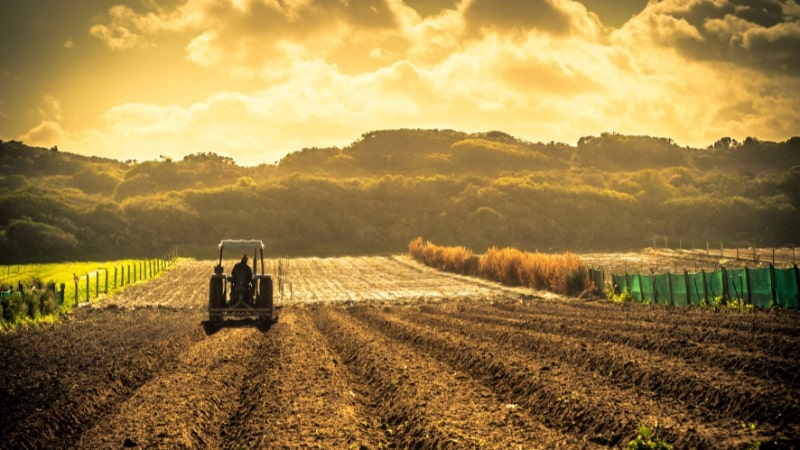On February 6th, we experienced a highly destructive earthquake with its epicenter in Kahramanmaraş. The earthquake caused significant devastation in Kahramanmaraş, Hatay, Kilis, Diyarbakır, Adana, Osmaniye, Gaziantep, Adıyaman, Şanlıurfa, and Malatya. According to official figures, the earthquake resulted in a loss of more than 50,000 lives and many buildings either collapsed or suffered severe damage. Naturally, agriculture and food were also affected. In this article, we discuss the Earthquake’s Impact in Turkey on agriculture, food, and livestock.
Agricultural lands and production facilities in the region suffered significant losses due to the earthquake’s impact. Debrises swalloweed the agricultural equipment burieng it under earth, and the region experienced a loss of workforce due to fatalities and mandatory migrations following the earthquake. The earthquake also had adverse effects on the environment and underground water sources.
The Extent of the Damage
According to the report prepared by the Presidency Strategy and Budget Directorate, the damages and losses in agriculture caused by the earthquake’s impact in Turkey have reached 24.2 billion Turkish liras, based on the initial assessments.
The Food and Agriculture Organization of the United Nations (FAO) evaluated the effects of the earthquakes centered in Kahramanmaraş in February on agricultural production in Turkey.
In a statement by the United Nations, it was mentioned that “Initial assessments indicate significant impacts on agriculture with preliminary estimates of $5.1 billion in losses and $1.3 billion in damages in the sector.”
In a written statement by the FAO, it was stated that “Devastating earthquakes hit the south of Turkey and the north of Syria on February 6, 2023. Initial assessments of the earthquakes’ impact in Turkey show serious damages in the affected regions in terms of agricultural infrastructure, livestock, crops, fisheries, and aquaculture.”
The statement further mentioned, “The earthquake severely affected 15.7 million people in Turkey and 11 agricultural cities that account for over 20% of the country’s food production. The region affected by the earthquake, known as Turkey’s ‘fertile crescent,’ constitutes 15% of the agricultural gross domestic product (GDP) and contributes to 20% of Turkey’s agricultural food exports.”
Earthquake’s Impact in Turkey on Livestock
In addition to agriculture, it is stated that the earthquake has also affected Turkey’s important livestock regions, leading to the death and serious injury of animals. The shortage of shelters and feed, interrupted vaccine production, risks of foot-and-mouth disease, and concerns about deteriorating livestock conditions after the earthquake have been raised.
Hamit Kurt, the Chairman of the Agriculture Orkam-Sen Inspection Board, prepared a report on Agriculture and Livestock in the earthquake-stricken region.
“In Turkey approximately 50,000 small and large livestock, around 3,000 beehives, and nearly 5,000 domestic animals (cats, dogs, birds, etc.) were observed to be perished in the region. Thousands of animals were injured due to the earthquake’s impact, and many animals had to be sold at prices below their value due to impossibility and compulsion by their owners.”
Earthquake’s Impact in Turkey To Reduce Fish Production by 7 Million Tons
The fishing industry in Kahramanmaraş, which holds an important position in trout farming in Turkey, has also been negatively affected by the earthquake, just like other sectors. Due to the significant damage to numerous facilities and mass fish deaths, a 40% decrease is expected in trout production, which is carried out in Kahramanmaraş and exported to 54 countries. Despite not having a coastline, the fish raised in the reservoirs of Kahramanmaraş are exported to 15 countries.
Trout raised in facilities established on reservoirs in Kahramanmaraş are exported to 15 countries, including Poland, Romania, Germany, Kuwait, Saudi Arabia, Russia, Lebanon, Qatar, Azerbaijan, Kazakhstan, Georgia, the United States, China, Iran, and Iraq.
Ibrahim Sarı, the President of the Kahramanmaraş Fishermen’s Association, stated that approximately 14 facilities suffered serious damage during the earthquake, and he announced that this year’s trout production is expected to decrease from 17 million tons last year to 10 million tons. He also added that mass fish deaths occurred in all of their land-based facilities due to water supply disruptions.
Due to the damage incurred at some private-sector inland aquaculture facilities in the earthquake-stricken region, 101 tons of fish and 37.4 million fish fry died, resulting in a total fish cost estimated at 63.2 million TL (3.4 million dollars).
Source: 2023 Kahramanmaraş and Hatay Earthquakes Report
According to the 2023 Kahramanmaraş and Hatay Earthquakes Report, approximately 5,756 out of the 1.6 million beehives in the region have been damaged. The estimated cost of replacing them is 8.6 million TL (456,000 dollars).
This year, these 15 countries will have to import trout from other countries, leading to a decrease in Kahramanmaraş’s fish exports and the amount it would earn from exports.
Earthquake’s Impact in Turkey on Food and Agriculture — Vegetables, Fruits, and Nuts
Malatya is known for its apricot production, while Gaziantep is the capital of Antep pistachios. Hatay has the highest mandarin orange production in Turkey and is the second-largest producer of plums. Kahramanmaraş is among the leading provinces in walnut production. Adıyaman ranks first in tobacco production in Turkey.
The earthquake-affected region accounts for 8.7% of Turkey’s vegetable production and 16.9% of fruit production. Without taking necessary measures, there is a significant risk of a significant decline in yields in certain fruit varieties.
Hatay takes the lead in Turkey for products such as parsley, chard, plums, lettuce, citrus fruits, pumpkin, carrots, peas, okra, mint, eggplant, olives, garlic, onions, turnips, cape gooseberries, and Trabzon dates. While fruit orchards account for 14.04% of Turkey’s total agricultural areas, Hatay’s share reaches 35.43%. Olive groves cover 51,841 hectares of this area. The total share of vegetable areas in Hatay is nearly three times the national average.
In Malatya, production is primarily based on apricots. The annual average production of dried apricots is around 80,000 to 100,000 tons. Turkey accounts for 90% of the global dried apricot market, with 70% belonging to Malatya.
The region holds 82.7% of Turkey’s pistachio production, with Gaziantep accounting for 23.4% and Adıyaman for 11.3% of the production. Adıyaman also has a significant share in chickpea and garlic production. Hatay contributes 2% of Turkey’s corn production, while Kahramanmaraş contributes 3%. The region supplies 17.8% of Turkey’s almond production, with Adıyaman accounting for that share. Hatay alone carries out 20.8% of Turkey’s citrus fruit production, contributing to 57.5% of the country’s total. In olive production, the region accounts for 16% of Turkey’s output, with Hatay having a 4% share.
Our exports in February decreased by 6.4% compared to the same month last year, reaching 18.6 billion dollars. According to customs data, there has been a significant decrease in exports, particularly in Hatay, Adıyaman, Malatya, and Kahramanmaraş, after the earthquake.
After the earthquake, apricots remained unsold, farmers wait
In Malatya, one of the cities most affected by the earthquake on February 6th, apricots remained unsold by the farmers. The Great Şire Market in Malatya also suffered significant damage due to the earthquake. Despite challenging conditions, efforts are being made to prepare for the new apricot season in Malatya, which meets 85% of the world’s dried apricot demand.
Erhan Almendi, the Vice Chairman of Malatya Commodity Exchange, stated that there has been a significant decline in dried apricot exports following the earthquakes with magnitudes of 7.7 and 7.6, centered in Pazarcık and Elbistan. However, he expressed belief that this situation will be overcome.
Erhan Almendi emphasized the importance of apricots for the recovery of the city affected by the earthquakes, stating that Malatya is known as the “apricot capital of the world” and holds significant brand value.
Post-Earthquake Assistance and Recommendations
The Food and Agriculture Organization of the United Nations (FAO) is requesting $112 million to provide cash, livestock, and agricultural support to 900,000 people in rural areas affected by the earthquake.
According to a report prepared by the Presidency of Strategy and Budget, short-term measures that need to be taken include repairing damaged barns and sheds, rebuilding the collapsed ones, providing animal tents for animals with shelter problems due to the destruction of barns and sheds, and supplying roughage, concentrated feed, medication, and vaccines to livestock breeders.
The repair and reconstruction of facilities such as warehouses, processing plants, and silos, compensating for the losses incurred due to animal deaths, providing seed and fertilizer support to farmers to ensure spring planting, and taking measures to employ sufficient seasonal agricultural workers in the region are also included in the short-term policy recommendations.
We are including our exporters in the earthquake-affected region in the “Earthquake Zone Campaign” within the Coimex community.
We have prepared a campaign called the “Earthquake Zone Campaign” to support traders in the earthquake-affected region and contribute to their continuation of international trade during these challenging times. If your factory or central office is located in Hatay, Kahramanmaraş, Gaziantep, Malatya, Adıyaman, Şanlıurfa, Kilis, Diyarbakır, Şırnak, Adana, or Osmaniye, we are immediately opening your FREE Coimex account. After you make your first sale through Coimex, we will start your paid membership at a discounted rate. You can access the details of the campaign from here.
Contact us now to join the Coimex community for free.


Comments are closed.